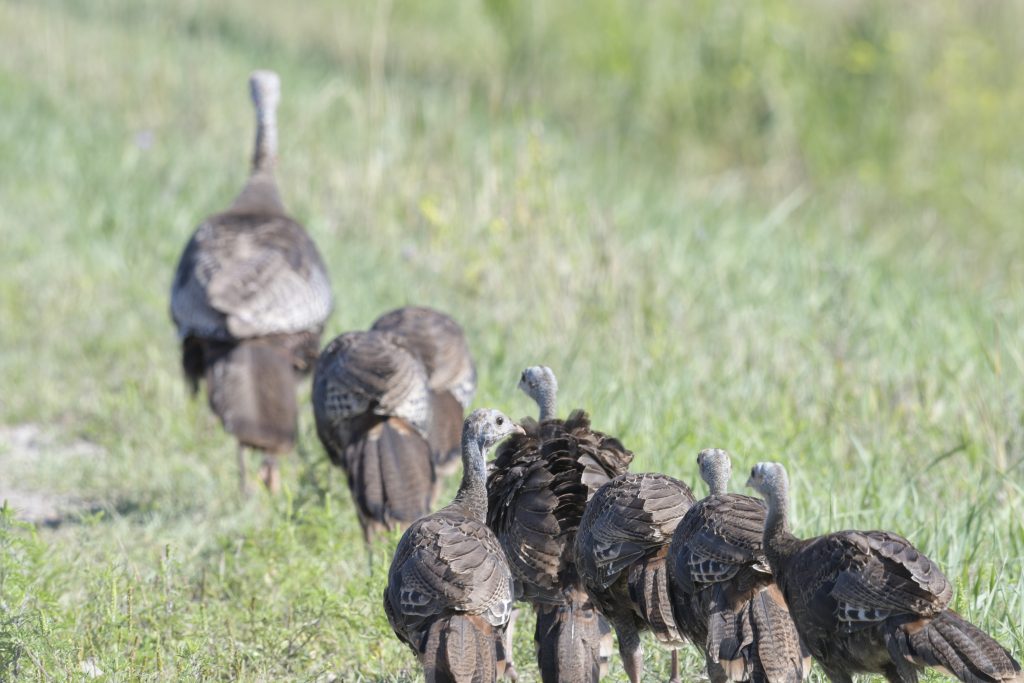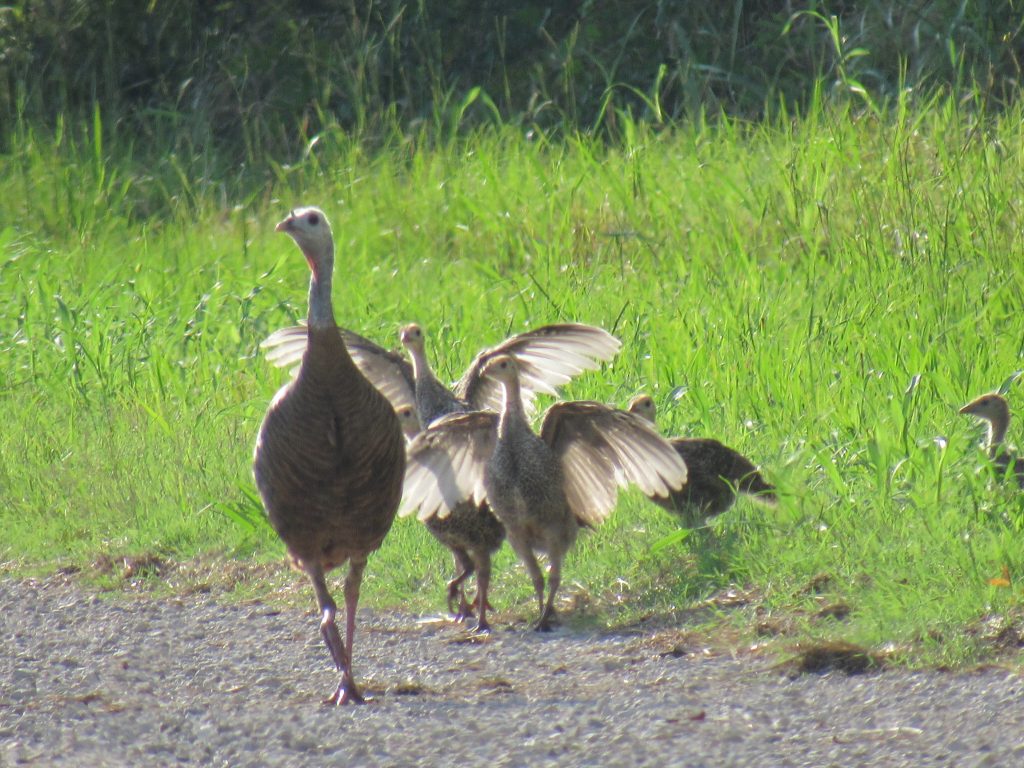Habitat for the Hatch: 2024 Forecast
Projects across the initiative's 18-state region are underway, improving nest success and poult recruitment.
From Texas to Florida and up into the northern reaches of Kentucky, private and public land projects under the umbrella of the NWTF's Habitat for the Hatch Initiative are hitting the ground running for the initiative's first full year, creating the nesting and brood-rearing habitat essential to hatching more poults and recruiting them into adulthood.
NWTF district biologists throughout the initiative's 18-state region are predicting a successful year for the work, conservatively impacting over 100,000 acres in the initiative's first full year.
"While our impact across this region will be much larger as we address the wild turkey's annual cycle needs, we want to ensure the acres under Habitat for the Hatch can be directly tied to increased nesting and brood-rearing habitat," said Doug Little, NWTF director of conservation operations for the East. "We know that creating quality habitat gives turkeys more opportunities to make more birds. We look forward to assessing our projects at the year's end and seeing how big our impact on nesting and brood-rearing habitat will be."
Habitat for the Hatch is enhancing public and private lands through various conservation and habitat management practices. Here is a broad overview across the initiative's range to create more turkeys:
Florida
Starting in Habitat for the Hatch's southeast-most corner, the Florida Wildlife Commission's Wild Turkey Cost Share program allows the NWTF, FWC and partners to pool their resources to fund habitat management projects on public lands open to turkey hunting. Since the Wild Turkey Cost Share Program began in 1994, partners have spent over $7 million to improve public land wild turkey habitat. For 2024, partners are collaboratively spending $1.7 million to enhance public lands through 21 different projects.
One of the great projects within the Florida Wild Turkey Cost-share Program for 2024, that is also part of the NWTF’s Habitat for the Hatch Initiative, is work being done the Upper Hillsborough WMA. This project will mechanically reduce mid-story trees and shrubs to increase forest floor sunlight and facilitate prescribed fire. This project is a partnership with Southwest Florida Water Management District and will treat 100 acres, drastically improving brood-rearing habitat for wild turkeys.
"We have created something special for the wild turkey in Florida," said Ricky Lackey, NWTF district biologist for Florida, Georgia and South Carolina. "Since 2012, we have conserved over 954,012 acres of wild turkey habitat in Florida. We are actively creating the nesting and brood-rearing habitat wild turkeys need on a landscape scale; this is how we create more turkeys."
Georgia
Lackey and NWTF's volunteers also have big plans in Georgia. The NWTF Georgia State Chapter is slated to impact nesting and brood-rearing habitat through 15 projects, allocated from an over $97,000 investment from the chapter's Super Fund. The Georgia NWTF State Chapter also allocated an additional $10,000 for use across Habitat for the Hatch’s 18-state region.
One of those 15 projects for 2024 is a targeted herbicide application at Ohoopee Dunes WMA. This selective herbicide application will treat woody encroachment in a recently thinned pine stand, promoting more native grasses and forbs.
South Carolina
Likewise, the South Carolina NWTF State Chapter volunteers provided $50,000 to Habitat for the Hatch in 2024 to make an impact across the initiative's 18-state region.
The NWTF's volunteers in the Palmetto State also allocated $181,325 to 13 projects across the whole state via the South Carolina Department of Natural Resources Habitat Enhancement Program.
One of those projects, as part of Habitat for the Hatch, is restoration work at the Bobwhite Hills Wildlife Area. This project is in partnership with Quail Forever and SCDNR. Work entails restoring 774 acres of longleaf pine savanna, through management practices such as herbicide treatments, mulching, fireline establishment and prescribed fire. This project will greatly increase nesting and brood-rearing habitat for wild turkeys.

Alabama
Moving on to some of the central areas in Habitat for the Hatch's 18-state region, the Alabama NWTF State Chapter and partners are contributing over $890,000 to 19 projects throughout the state that will contribute to Habitat for the Hatch. From the early successional habitat management in the Barbour WMA in the southeast corner of the state to the management in the Bankhead National Forest in the northwest corner, turkeys can expect more habitat for the hatch in Alabama.
For example, on the Bankhead National Forest, the state chapter provided $1,610, matched with nearly $11,000 from the USDA Forest Service to purchase and utilize a boom sprayer to control invasive species such as lespedeza and kudzu. This year, over 150 acres will be treated, allowing for an increase in native plant growth and thus higher quality nesting and brooding habitat.
In addition, the Alabama NWTF State Chapter allocated $50,000 to be used across Habitat for the Hatch's 18-state region, providing funds for other states that might need more match funding to make a project come to fruition or to increase the impact of a project in a different state.
Kentucky
Kentucky has eight projects contributing to the Habitat for the Hatch Initiative. The Kentucky NWTF State Chapter anticipates these projects will contribute 2,470 acres toward the initiative with an overall financial impact of over $2 million with partner matching funds.
In Kentucky, a Habitat for the Hatch project is creating nearly 200 acres of early successional habitat on Griffith Woods WMA, in partnership with the Kentucky Department of Fish and Wildlife. The partnership utilized mulching and fireline creation valued at almost $40,000 to create quality brood habitat across the WMA.
Tennessee
Likewise, the NWTF volunteers in Tennessee anticipate that nine brood-rearing and nesting projects will contribute 11,724 acres toward the initiative with an overall financial impact of $596,857 with partner match.
The state chapter in Tennessee was able to team up with the Tennessee Wildlife Resources Agency and the Tennessee Department of Environment and Conservation to create early successional habitat on Fate Sanders State Natural Area within the Percy Priest WMA. The partners utilized over $22,000 to rent a mulcher to recapture over 200 acres of native prairie that had been overtaken by cedar. Step two in the project will be using herbicide to control any additional invasive plants, ultimately allowing the area to be managed with prescribed fire.
"The volunteers in Alabama, Kentucky and Tennessee know the importance of creating essential nesting and brood-rearing habitat through results-driven projects," said Derek Alkire, NWTF district biologist for Alabama, Kentucky and Tennessee. "They helped raise necessary funds and determined the best projects to invest in the wild turkey. We are looking forward to this year's accomplishments."
North Carolina
NWTF volunteers in North Carolina are proud to fund numerous public land projects that contribute to Habitat for the Hatch. The Lantern Acres Game Land project, for instance, in the North Carolina Wildlife Resources Commission's Central Coast Region, entails removing trees and applying herbicide to set back succession and create young forest habitat. Forty-one acres will be impacted through this collaborative project.
The Sandhills Game Land project contributes to restoring longleaf pine ecosystems near the coast by planting wiregrass to create ground cover in longleaf ecosystems. Similarly, the Rocky Run Game Land project is doing 81 acres of the same work in the Central Coast Region in Onslow County. Both projects will provide the vital ground cover hens and poults need during the spring and summer.
Virginia
Virginia has some excellent projects amplifying Habitat for the Hatch, too. For instance, in conjunction with the U.S. Army Corp of Engineers, the John Kerr Dam and Reservoir project maintains existing wildlife openings, creating new areas for brood range and supporting activities to complete prescribed fire that will set back succession. The Virginia NWTF State Chapter committed $7,500 from its Super Fund to the 60-acre project.
In addition, NWTF volunteers in the Old Dominion contributed funds to the Century Project on the Virginia Department of Wildlife Resources Flippo-Gentry WMA in Sussex County. The project combines management objectives to restore a significant longleaf pine forest. The project will use prescribed fire across 450 to 500 acres of the WMA annually. In addition, turkey and quail brood-rearing fields will be established throughout the WMA. A combination of rotational discing and fire will manage these fields through time and provide excellent quail chick and turkey poult brood-rearing cover. Turkey populations will increase along with quail populations. The Virginia NWTF State Chapter allocated $25,000 toward the project, which is currently in progress.
“The volunteers in Virginia and North Carolina appreciate the opportunity to assist public land managers with meeting their habitat management objectives,” said Cully McCurdy, NWTF district biologist for Noth Carolina, Virginia and West Virginia. “Allocated funds by the state chapters will receive significant match from the agencies to expand habitat improvements for wild turkeys and other wildlife. The collaboration is a win-win situation for hunters and land managers.”

Mississippi
Moving over to some of the Gulf Coast states within the Habitat for the Hatch Initiative, Mississippi has some great projects in the works.
In conjunction with the Mississippi Department of Wildlife Fisheries and Parks, the Mississippi NWTF State Chapter funded an invasive species treatment in the Pascagoula WMA. This project will selectively treat 35 acres of an oak timber stand, which has been taken over by Chinese tallow tree. The stand can provide quality nesting and brooding cover for wild turkeys once the mid-story is cleared and native vegetation is encouraged. Optimal understory cover for wild turkey nesting and brood rearing is limited on the WMA, so identifying areas that provide this habitat is critical.
“Pascagoula WMA is unique in that it has upland pines in a predominately hardwood forest,” said Kacie Bauman, NWTF district biologist for Arkansas, Louisiana and Mississippi. “Quality nesting and brooding habitat on the WMA is severely restricted due to invasive plant species that have taken over the WMA, such as the Chinese Tallow Tree. Treating these areas will allow for the native vegetation to take place once again and be maintained through prescribed fire, allowing turkeys to utilize the area and provide a much more conducive habitat to raise their young.”
Texas
Numerous projects are bolstering Habitat for the Hatch's impact on private lands in the initiative's westernmost state.
In conjunction with the Texas Parks and Wildlife Department and the Northeast Texas Conservation Delivery Network's Habitat Incentive Program, many landowners are applying to be a part of TWPD's Eastern Wild Turkey Super Stocking project (learn more about the Super Stocking Project).
Before landowners can qualify to be a part of Super Stocking efforts, they must have habitat suitable for turkeys to thrive, including good nesting and brooding areas.
Annie Farrell, NWTF district biologist and Habitat Incentive Program administrator for the Northeast Texas Conservation Delivery Network, has a key management role in the incentive program, from ranking proposals to creating landowner agreements to processing payments.
"The NWTF pays landowners a certain amount per acre for doing habitat practices such as prescribed burning, herbicide and mulching," Farrell said. “Considerable funding is focused on habitat work in TPWD's Eastern wild turkey priority areas, which include the Sulphur River, Neches River and Trinity River Priority Areas. About $1.2 million has been allocated so far to private landowners."
From private lands work in east Texas to the Wild Turkey Cost Share program in Florida, projects under the NWTF's Habitat for the Hatch Initiative are underway in the initiative's first full year.
For more information about Habitat for the Hatch in your area, contact your local NWTF district biologist:
Ricky Lackey – Florida, Georgia and South Carolina rlackey@nwtf.net
Cully McCurdy – North Carolina, Virginia and West Virginia cmccurdy@nwtf.net
Derek Alkire – Alabama, Kentucky and Tennessee dalkire@nwtf.net
Kacie Bauman – Mississippi, Louisiana and Arkansas kbauman@nwtf.net
Annie Farrell – Texas afarrell@nwtf.net
John Burk – Missouri jburk@nwtf.net
Ryan Boyer – Ohio rboyer@nwtf.net
